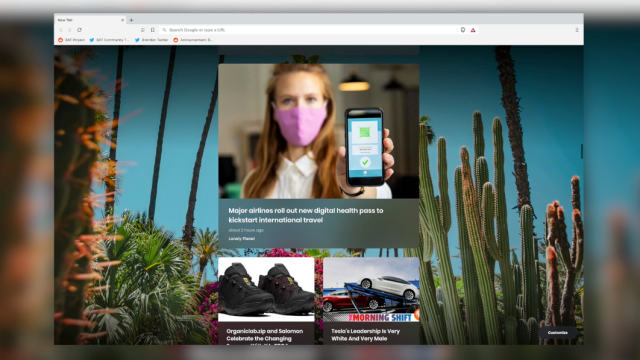Brave is continuing its war against data-collection giants like Google with the introduction of a privacy-centered news reader to its privacy-centered web browser.
The company announced the launch of the Brave Today news reader on Thursday, and people who already use its browser don’t need to do anything to check out the new feature. It’s right there on the home page when a new window is opened. Outside of the privacy protections, Brave Today should be a fairly familiar experience. Scrolling down the page displays a running feed of stories pulled from hundreds of news outlets that are sortable by category. Clicking “customise” allows you to disable any outlet of your choosing. It’s like Google News but less cluttered on the visual level.
[referenced id=”1234504″ url=”https://gizmodo.com.au/2020/07/i-was-horrified-at-how-many-ads-the-new-brave-browser-and-vpn-for-ios-blocked/” thumb=”https://gizmodo.com.au/wp-content/uploads/2020/07/28/tlpc04emybdmlofwdnjd-300×169.jpg” title=”I Was Horrified at How Many Ads the New Brave Browser and VPN for iOS Blocked” excerpt=”Between a minefield of ads and trackers, browsers have added a number of security and privacy features over the past few years. Brave is the latest, announcing today that it’s partnering up with Guardian to launch a new version of its iOS browser, Brave Firewall + VPN.”]
It’s also less-cluttered than Google News under the hood. Brave doesn’t use tracking links to follow users around the web and compile dossiers of their behaviour. And Brave is directing users to the publisher rather than diluting their brand and revenue with proxies like Google AMP or Apple News’s in-app display.
Alongside Brave Today, the company announced a new content delivery network that separates a user’s requested content from their IP address. Each process is handled by a different piece of the system, and Brave has implemented a special agreement with its CDN provider to ensure that data isn’t unencrypted and combined by another party. The company also explained how to verify that your data is being sent where it claims and emphasised that further verification of its system is simple because its browser is open source.
What’s the downside? Well, there’s still advertising on the page, it’s just not hyper-targeted like Google’s ads. Brave partners tend to lean heavily on cryptocurrency-related projects, so expect to see ads for exchanges instead of that one Ham Crystal that’s been following you ever since you clicked a link in a gift guide.
Another drawback is that you can’t manually add new RSS feeds to the reader, but Brave said that feature is coming in an upcoming release.
